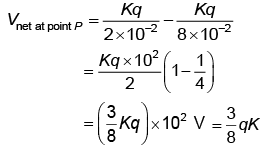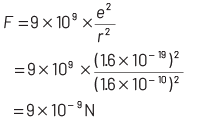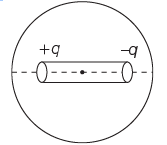NEET Previous Year Questions (2014-2024): Electric Charges & Fields | Physics Class 12 PDF Download
2024
Q1: A thin spherical shell is charged by some source. The potential difference between the two points C and P (in V) shown in the figure is: [2024]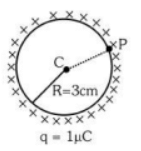 (Take
(Take  SI Units)
SI Units)(a) 3 x 105
(b) 1 x 105
(c) 0.5 x 105
(d) Zero
 View Answer
View AnswerAns: (d)
For uniformly charged spherical shell,
2023
Q1: If over a surface, then
over a surface, then (a) The number of flux lines entering the surface must be equal to the number of flux lines leaving it
(b) The magnitude of the electric field on the surface is constant
(c) All the charges must necessarily be inside the surface
(d) The electric field inside the surface is necessarily uniform
 View Answer
View AnswerAns: (a)
⇒ Net flux through the surface is zero.
⇒ Therefore, the number of flux lines entering the surface must be equal to the number of flux lines leaving it.
Q2: The net magnetic flux through any closed surface is
(a) Zero
(b) Positive
(c) Infinity
(d) Negative
 View Answer
View AnswerAns: (a)
Magnetic monopole doesn't exist.
Hence net magnetic flux through any closed surface is zero.

The electric potential at point P due to the dipole is (ε0 = permittivity of free space and 
2022
Q1: Two point charges –q and +q are placed at a distance of L, as shown in the figure 
The magnitude of electric field intensity at a distance R(R >>L) varies as:
(a) 1/R3
(b) 1/R4
(c) 1/R6
(d) 1/R2
 View Answer
View AnswerAns: (a)
For R >>L, arrangement is an electric dipole 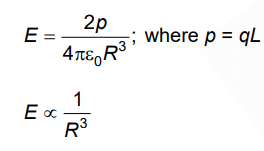
2021
Q1: Polar molecules are the molecules:
(a) acquire a dipole moment only when the magnetic field is absent.
(b) having a permanent electric dipole moment.
(c) having zero dipole moment.
(d) acquire a dipole moment only in the presence of an electric field due to displacement of charges.
 View Answer
View AnswerAns: (b)
Polar molecules have centers of positive and negative charges separated by some distance, so they have permanent dipole moments.
Q2: A dipole is placed in an electric field as shown. In which direction will it move? 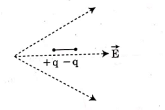
(a) towards the left as its potential energy will decrease.
(b) towards the right as its potential energy will increase.
(c) towards the left as its potential energy will increase.
(d) towards the right as its potential energy will decrease.
 View Answer
View AnswerAns: (d)
E1| > |E2| as field lines are closer at charge +q, so the net force on the dipole acts towards the right side.
A system always moves to decrease its potential energy.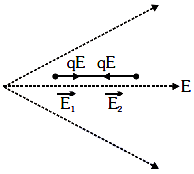
2020
Q1: A short electric dipole has a dipole moment of 16×10-9 C m. The electric potential due to the dipole at a point at a distance of 0.6 m from the center of the dipole, situated on a line making an angle of 60° with the dipole axis is: 
(a) 400 V
(b) Zero
(c) 50 V
(d) 200 V
 View Answer
View AnswerAns: D


Q2: A spherical conductor of radius 10 cm has a charge of 3.2 × 10−7 C distributed uniformly. What is the magnitude of electric field at a point 15 cm from the centre of the sphere? 
(a) 1.28 × 105 N/C
(b) 1.28 × 106 N/C
(c) 1.28 × 107 N/C
(d) 1.28 × 104 N/C
 View Answer
View AnswerAns: (a)
Given, radius, r = 10 cm = 10 × 10 −2 m Charge, q = 3.2 × 10 −7 C Electric field, E = ?
Electric field at a point (x = 15 cm) from the centre of the sphere is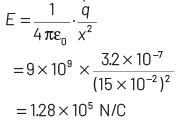
Hence, correct option is (a).
Q3: The electric field at a point on the equatorial plane at a distance r from the centre of a dipole having dipole moment r P is given by (r >> separation of two charges forming the dipole, ε 0 = permittivity of free space)
(a) 
(b) 
(c) 
(d) 
 View Answer
View AnswerAns: (a)
Electric field due to electric dipole on equatorial plane at a distance r from the centre of dipole is given as
2019
Q1: A hollow metal sphere of radius R is uniformly charged. The electric field is due to the sphere at a distance r from the
center.
(a) Increases as r increases for both r < R and r > R
(b) Zero as r increases for r < R, decreases as r increases for r > R
(c) Zero as r increases for r < R, increases as r increases for r > R
(d) Decreases as r increases for both r < R and r > R
 View Answer
View AnswerAns: (b)
Charge Q will be distributed over the surface of a hollow metal sphere.
(i) For r < R (inside)
By Gauss law,
⇒ Ein = 0 (∵ qen = 0)
(ii) For r > R (outside)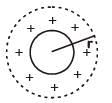

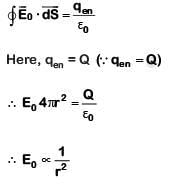
Q2: Two parallel infinite line charges with linear charge densities +λ C/m and λl C/m are placed at a distance of 2R in free space. What is the electric field mid-way between the two line charges?
(a) Zero
(b)
(c)
(d)
 View Answer
View AnswerAns: (c)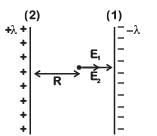

Electric field due to line charge (1)
Electric field due to line charge (2)

Q3: Two point charges A and B, having charges +Q and –Q respectively, are placed at a certain distance apart, and the force acting between them is F. If 25% charge of A is transferred to B, then the force between the charges becomes :
(a) F
(b) 9F/16
(c) 16F/9
(d) 4F/3
 View Answer
View AnswerAns: (b)

If 25% of the charge of A transferred to B then
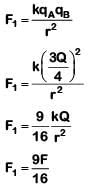
2018
Q1: An electron falls from rest through a vertical distance h in a uniform and vertically upward-directed electric field E. The direction of the electrical field is now reversed, keeping its magnitude the same. A proton is allowed to fall from rest through the same vertical distance h. The time fall of the electron, in comparison to the time fall of the proton is:
(a) Smaller
(b) 5 times greater
(c) 10 times greater
(d) equal
 View Answer
View AnswerAns: (a)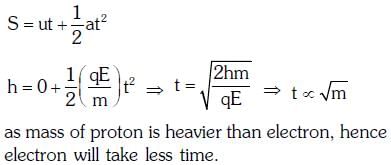
Q2: A toy car with charge q moves on a frictionless horizontal plane surface under the influence of a uniform electric field Due to the force
Due to the force its velocity increases from 0 to 6 m/s in one-second duration. At that instant, the direction of the field is reversed. The car continues to move for two more seconds under the influence of this field. The average velocity and the average speed of the toy car between 0 to 3 seconds are respectively:
its velocity increases from 0 to 6 m/s in one-second duration. At that instant, the direction of the field is reversed. The car continues to move for two more seconds under the influence of this field. The average velocity and the average speed of the toy car between 0 to 3 seconds are respectively:
(a) 2 m/s, 4 m/s
(b) 1 m/s, 3 m/s
(c) 1 m/s, 3.5 m/s
(d) 1.5 m/s, 3 m/s
 View Answer
View AnswerAns: (b)
0 < t < 1s : velocity increases from 0 to 6 m/s
1 < t < 2s : velocity decreases from 6 to 0 m/s
but the car continues to move forward
2 < t < 3s : since field strength is same ⇒ same acceleration
∴ car's velocity increases
from 0 to –6 m/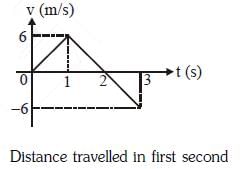
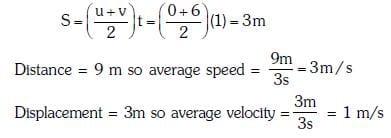
2017
Q1: Suppose the charge of a proton and an electron differ slightly. One of them is − e and the other is (e + ∆e). If the net of electrostatic force and gravitational force between two hydrogen atoms placed at a distance d (much greater than atomic size) apart is zero, then ∆e is of the order [Given mass of hydrogen, mh = 1.67 × 10−27 kg]
(a) 10−20 C
(b) 10−23 C
(c) 10 −37C
(d) 10 -47C
 View Answer
View AnswerAns: (c)
Net charge on one H-atom q = − e + e + ∆e = ∆e Net electrostatic repulsive force between two H-atoms Similarly, net gravitational attractive force between two H-atoms
Similarly, net gravitational attractive force between two H-atoms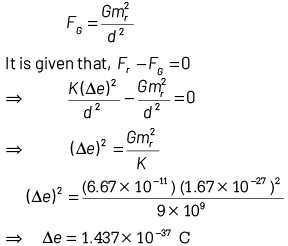
2016
Q1: Two identical charged spheres suspended from a common point by two mass-less strings of lengths ℓ are initially at a distance d (d << ℓ) apart because of their mutual repulsion. The charges begin to leak from both spheres at a constant rate. As a result, the spheres approach each other with a velocity v. Then v varies as a function of the distance x between the spheres, as:
(a) v ∝ x-1
(b) v ∝ x1/2
(c) v ∝ x
(d) v ∝ x-1/2
 View Answer
View AnswerAns: (d)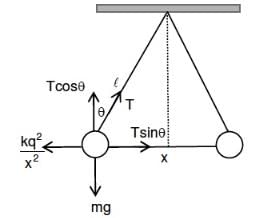
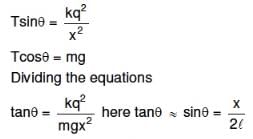

Q2: An electric dipole is placed at an angle of 30° with an electric field of intensity 2 × 105 N C-1. It experiences a torque equal to 4 N m. Calculate the magnitude of charge on the dipole, if the dipole length is 2 cm.
(a) 8 mC
(b) 6 mC
(c) 4 mC
(d) 2 mC
 View Answer
View AnswerAns: (d)
E = 2 × 105 N/C
l = 2 cm
τ = 4 Nm 4 = pEsinθ
4 = pEsinθ
4 = p × 2 × 105 × sin30°
p = 4 × 10–5 cm
2015
Q1: The electric field in a certain region is acting radially outward and is given by E = Ar. A charge contained in a sphere of radius = a centered at the origin of the field will be given by:
(a)
(b)
(c)
(d)
 View Answer
View AnswerAns: (d)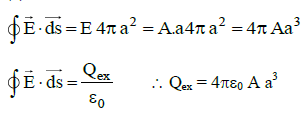
|
98 videos|332 docs|102 tests
|
FAQs on NEET Previous Year Questions (2014-2024): Electric Charges & Fields - Physics Class 12
| 1. What are the basic properties of electric charges? |  |
| 2. How does Coulomb's law describe the force between two charges? |  |
| 3. What is the concept of electric field and how is it calculated? |  |
| 4. How do conductors and insulators differ in terms of electric charges? |  |
| 5. What role do electric field lines play in understanding electric fields? |  |


